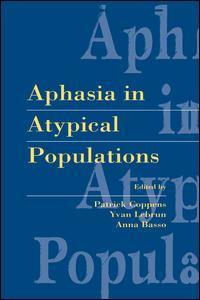Aphasia in Atypical Populations
Coordonnateurs : Coppens Patrick, Lebrun Yvan, Basso Anna

Theory and research in aphasiology have typically concentrated on a limited population--right-handed adult monolinguals whose language uses an alphabetic code. Bilingual individuals, ideographical code users, and children (among others) have been separated out. This book examines the available data from these "atypical" aphasics, asking whether what makes them different has a significant effect on language representation and processing in the brain. Each chapter reviews literature pertinent to a given population and explores whether (and potentially how) these populations differ from the "typical" aphasic population. The ultimate goal is to better understand whether the model of language used in aphasiology can be extended to these "atypical" populations, or conversely, whether significant differences merit the development of a new model.
Contents: Preface. A. Basso, M-L. Rusconi, Aphasia in Left-Handers. M. Paradis, Aphasia in Bilinguals: How Atypical Is It? P.F. Paquier, H.R. van Dongen, Is Acquired Childhood Aphasia Atypical? J. Gandour, Aphasia in Tone Languages. A. Yamadori, Aphasia in Ideograph Readers: The Case of Japanese. P. Coppens, M.A. de Mattos Pimenta Parente, A.R. Lecours, Aphasia in Illiterate Individuals. P. Coppens, S. Hungerford, Crossed Aphasia. D. Corina, Aphasia in Users of Signed Languages. P. Coppens, Y. Lebrun, A. Basso, How Atypical Are the Atypical Aphasias?
Date de parution : 11-2015
13.8x21.6 cm
Thèmes d’Aphasia in Atypical Populations :
Mots-clés :
aphasic; patients; wernicke's; affective; prosody; conduction; type; left; hemisphere; lesion; RCPM Score; Familial Sinistrality; American Sign Language; Left Hemisphere Lesion; Oral Apraxia; Conduction Aphasia; Language Lateralization; Left Handed Patients; Bilateral Language Representation; IMA; Subcortical Aphasia; Sign Language Aphasia; Unschooled Subjects; Unschooled Individuals; Illiterate Subjects; Deaf Signers; Kanji Words; Affective Prosody; Left Hemisphere Language Dominance; Asl Syntax; Left Posterior Inferior Frontal Gyrus; Asl Classifier; Limb Apraxia; Asl; Left Posterior Superior Temporal Gyri



